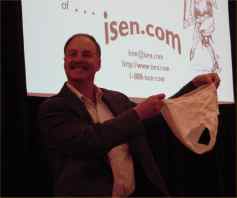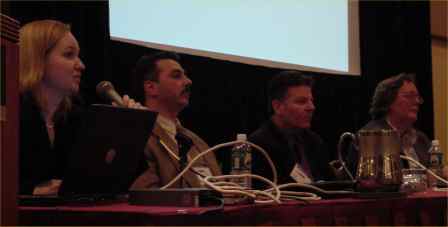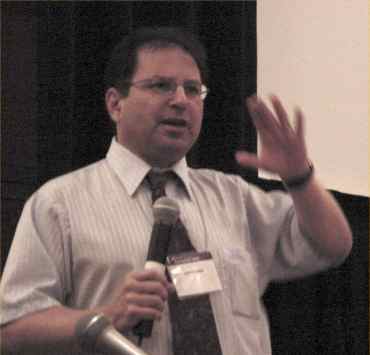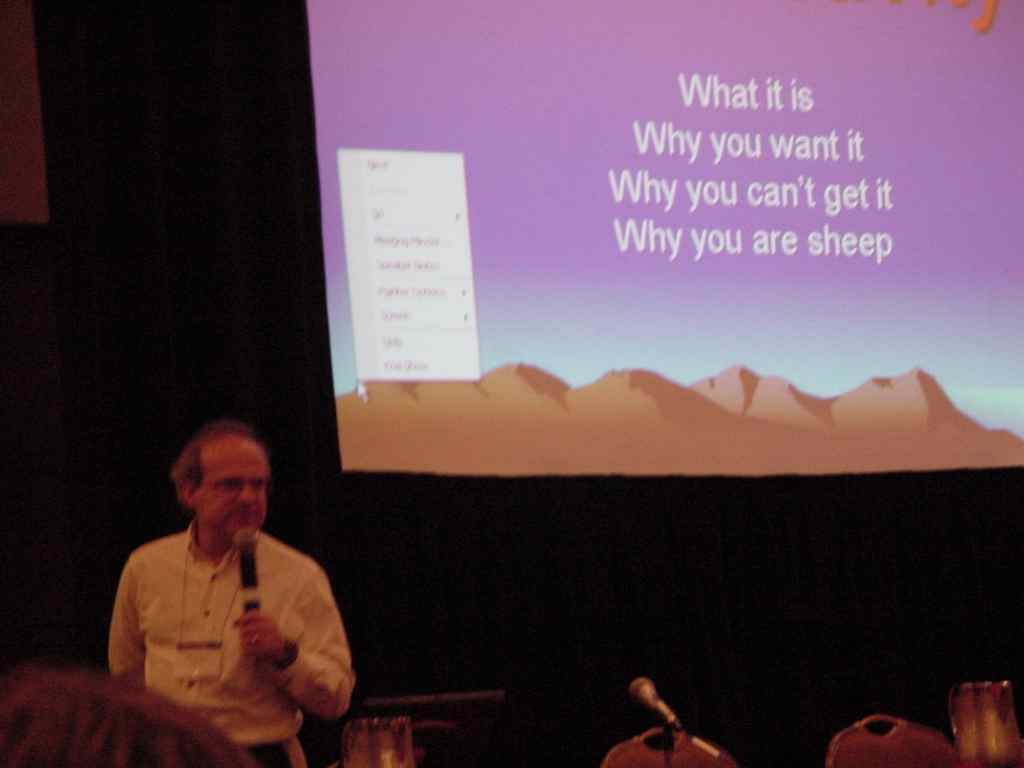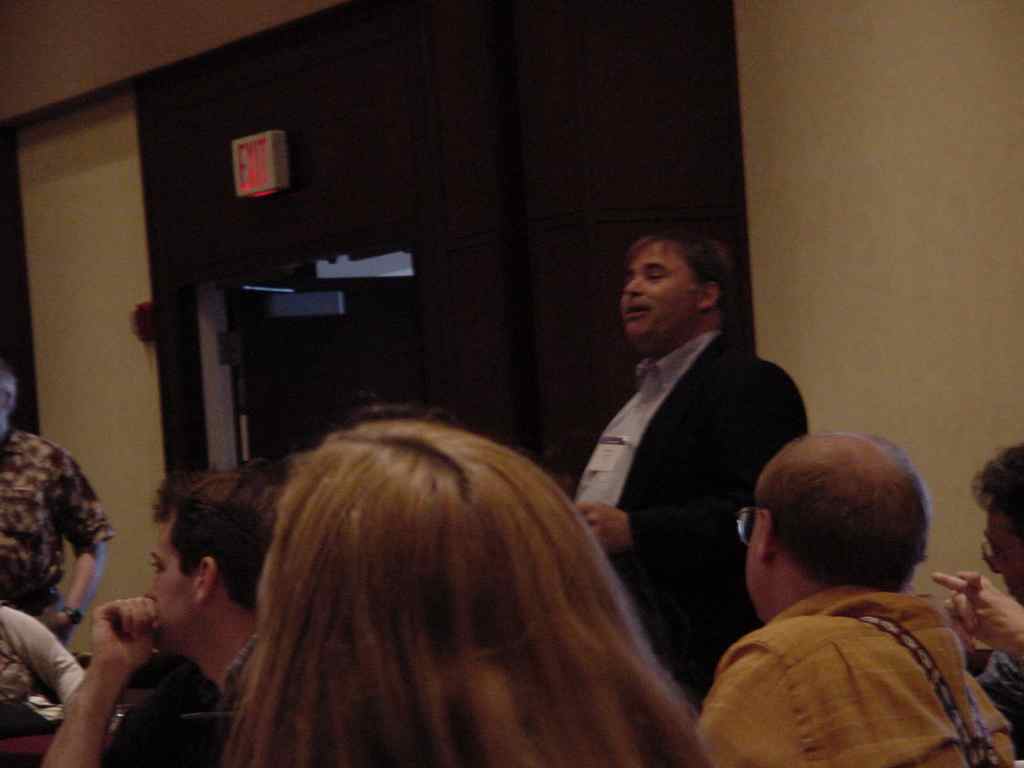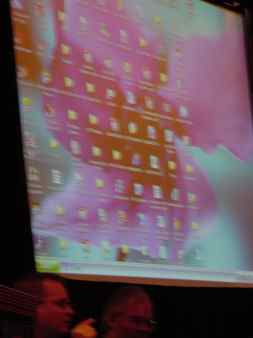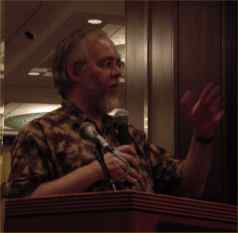May 22, 2002
Connectivity 2002 – Wednesday Morning
Connectivity 2002 – Wednesday Morning
Back at the Connectivity 2002 conference. Bob Frankston is giving the morning’s introduction, boiling it all down. Here’s his slide:
Connectivity: The Concept
Separate transport from content
– Pack connectivity like the Internet
– Functions defined at the end point
Current situtation
– Inherent conflict of interest
– Egregious restrictions on free speech
Bob is pushing on his “More is More” (More’s Law) that says that you want to be in a situation where if you want more of something, you can buy more. This makes for a healthy market. But the current situation isn’t like that: if you buy more set-top boxes, you don’t get more channels or more choice. But it should be true for connectivity: if you buy more streams, you get more capacity. This puts connectivity into the market where market forces can work its magic. Currently, broadband, on the other hand, is a set capacity with no ability to buy more. That’s why Bob said yesterday that he considers broadband to be a distraction; we shouldn’t be worrying about delivering broadband but about building a market where capacity is subject to market forces.
We just broke slightly (as the projector reboots) to let newcomers introduce themselves. David Burstein from Vortex – a big time telecomm forum – just brought us greetings from Doc Searls and news that we may have allies in quarters such as Cisco that would benefit greatly from a rapid growth in connectivity.
Frankston: “The thing about companies is that it’s not against the law to kill them.” His slide says that we are not saying they should die, “only” that they should reinvent themselves.
Audience: How does this work in rural areas? And what about the expense of rights of way?
Me: Doesn’t the logic of “More’s Law” lead to paying by bit, which we agree would be a bad thing?
Frankston: No, that’d just be a bad business model. [So, More’s Law actually says that we should be able to buy more in increments that maximize the market. After all, we can buy “more” now by moving within the upload/download increments in cable, and moving from dial-up to cable to T1, etc.]
Frankston: Rights of way is part of the “nefarious conspiracy” to keep this so expensive that only the incumbents can win. And we should open up the problem of rural access through innovation.
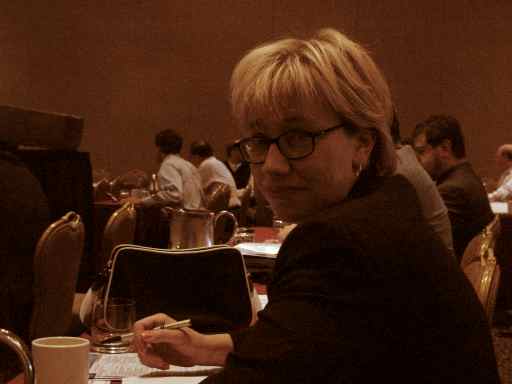
Halley Suitt takes a moment from blogging the conference…
Frankston: Content does have rights. And privileges. [I’m glad to see the conversation get down to the battle for the words that count.]
Bob is continuing to outline why breaking the hold of the “content providers” will open new business possibilities, e.g., aggregating content in flexible ways, etc. etc. I don’t need convincing on this point. But I’m also worried that we’re not seeing these new models already emerging. Some depend on greater access, but some – bands selling their own music over the Internet – could work now and yet haven’t caught on.
Frankston: “But it’s not all about entertainment. Some people have come to think that the purpose of the roof is to keep the rain off the television.”
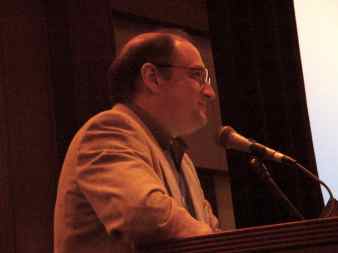
Bob DeRosa
Bob DeRosa, VP Mktg of American Fiber Systems, is up now. They design and develop metropolitan dark-fiber networks – fiber that can be used for whatever purposes the customer wants. (Thanks to David Isenberg for the explanation.) He’s explaining his competitive market: lots of groups (ILECs, CLECs, CATV, Gig-E players, utilities and more) are hooking wires up to your house. The “hidden competition” is the city itself: rights of ways, franchises and fees, permits, regulations and restoration demands. There’s some wiggle room, but “given the regulatory environment, competitors of any stripe are at a major disadvantage when competing against incumbents…”
I’m up supposedly up next leading a panel on “What the Fuck Do We Do about It?” Because this topic has come up pretty consistently in other panels, I instead, I want to have the entire group try to come up with the story by which we can explain the technological reasons for keeping the Net open. Divide into small groups, report back to the total group … the entire yechy, touchy-feely, marketing-offsite-meeting thing.
…Ok, I’m finished. We broke into groups and reported back. I can’t say that there were any tremendous breakthroughs, but it was – I hope – useful at least to begin talking with one another about this.
| Here’s what the groups came up with:
1. Transport and connectivity are different Split between:” everyone can be an ISP vs. This is a natural monopology which we hate but we’re going to get our net from the post office We were split between do we really need broadband and Broadband or Death. We’d send a politican back to look at national infrastructure projects, e.g., highway system. It’s not so much the post office as we need the network.) We sought a way to tie the self-itnerest of the legislator to the desire to achieve access to bb broadband. But what type of access? By facilitating universal access of any strength, you can induce the legislator to see it in his self-interest because the demographic can include new voters, by opening up access you open up particeipation in the electoral process. A number of the goals the Telecomm Act advanced have not been met (e.g., education). We wwant to promote 100mb/sec broadband. Platform neutrality. Might be wireless in rural, fiber to the home. Maybe through taxx breaks. It will serve the economy globally and locally. Do we attack the IP rights of the entertainment industry, which becomes an issue when you have the higher connection speeds? If we start talking about the RBOCs, we won’t get anywhere. So we have to frame this to meet the legislator’s self-interest by getting appropriations into the home district. We talk about the private road and the public road. The Internet is one of the greatest highway systems in the world but it’s being turned into a private road that serves private interests. Our country is rapidly losing employment to offshore competitors. How are enterpreneurs and people in disenfranchisede areas going to compete if they have worse access than, say, Korea and have to pay high prices? We’re shutting down the competition and our ability to be entrepreneurial in the global society. We need to create an “innovation platform.” The next great boom, like the Net’s first great stimulus of creativity, will come from the breakthrough of an innovation platform. |
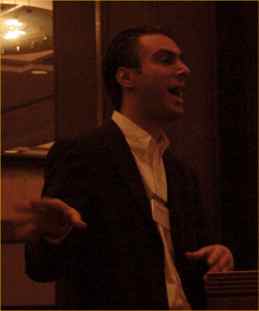
Kevin Werbach
Kevin Werbach is speaking. He’s not only the editor of Esther Dyson’s “Release 1.0,” he’s also an ex-FCC person. (He has a paper on this topic here. Regulators are well-intentioned, he says. They want broadband access nationally. They just lack the right way of talking about the issues. The “regulatorium” (Frankston’s term) exists for reasons. The FCC is under tremendous constraints: when you’re inside the FCC, all you see are the limits on what you can do.
Michael Powell has been spending his time marshalling his forces. He’s started at lesast five seprate broadband-related proceedings. He’s trying to push through his agenda but not much has happened.
What’s missing is the right information. They rely on what they’re told and mainly what they’re told comes from the established players. There’s a woeful lack of engineers and economists for independent internal analysis…but this is beginning to change. This is the best thing Powell is trying to do. Before, the FCC had lawyers but no engineers.
But the real problem is that the FCC doesn’t have the right paradigm. Its communications policy is based on the 1934 Communications Act. Today we have horizontal categories: teleecomm, broadcast, cable, Internet. But connectivity doesn’t fit into this model because it isn’t a service, it’s a platform for delivering many different services, e.g., Voice Over IP. But the FCC has to stick it into one existing bin or another. So, the most important questions simply don’t compute.
Is there a better alternative? Sure: Look at how the network actually works (today, not in 1934). There are vertical layers, not horizontal categories: not separate networks for voice, for pictures, etc. This is old news for techies (OSI stack, etc.) but it’s news to the law. Reconfigure the law to recognize perhaps four layers: content, apps/services, logical, physical. [This is very close to Lessig’s argument, which is certainly an argument in its favor.] This would let you put constraints on physical networks that would lead to greater openness higher in the stack. Not all-or-nothing regulations. (There are always going to be regulations.)
So, how do we get there? It’d be nice if we had a creative and committed FCC, but even then the courts would be a problem. So, we need new legislation. It’ll take time and money. We should start writing the Telecom Act of 2010. We need to recognize that the time frame is longer than 6 months. But we also need short-term tactical actions. Kevin helped draft the Stevens Report issued four years ago to explain why Internet telephony shouldn’t be regulated, so the FCC does occasionally do the right thing. But we need more input from the public and tech industry by informal meetings with the staff and by formal filings. The FCC keeps asking “Where’s the other side? Where’s this big tech industry?”
[Chris Herot just passed me a pointer to Dan Gillmor‘s excellent article on David Reed‘s excellent article on spectrum.]
Realtime Blogging
I blogged the TED conference a couple of months ago by taking notes (pen and paper, how primitive!) during the sessions and then spending a couple of hours each morning writing up entries before breakfast. I’m blogging the Connectivity 2002 conference in real time because there’s a wireless net here. The result is not only that I’m distracted from what’s going on, but you’re getting something much more like a spotty, inadequate transcript than a reflection on what’s important about the conference. You’re getting notes. I personally think the reflective model is more useful. But, because this conference is in my home town, the blogging time would have to come out of time spent with my family. And last night was the excellent two-hour season finale of “Buffy.”








